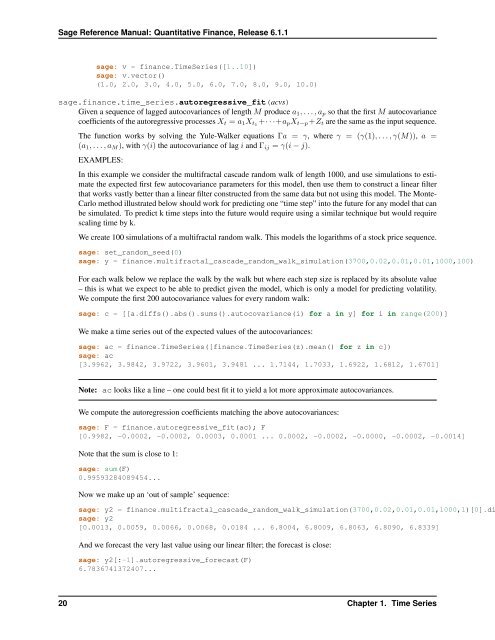Sage Reference Manual: Quantitative Finance - Mirrors
Sage Reference Manual: Quantitative Finance - Mirrors
Sage Reference Manual: Quantitative Finance - Mirrors
You also want an ePaper? Increase the reach of your titles
YUMPU automatically turns print PDFs into web optimized ePapers that Google loves.
<strong>Sage</strong> <strong>Reference</strong> <strong>Manual</strong>: <strong>Quantitative</strong> <strong>Finance</strong>, Release 6.1.1<br />
sage: v = finance.TimeSeries([1..10])<br />
sage: v.vector()<br />
(1.0, 2.0, 3.0, 4.0, 5.0, 6.0, 7.0, 8.0, 9.0, 10.0)<br />
sage.finance.time_series.autoregressive_fit(acvs)<br />
Given a sequence of lagged autocovariances of length M produce a 1 , . . . , a p so that the first M autocovariance<br />
coefficients of the autoregressive processes X t = a 1 X t1 +· · ·+a p X t−p +Z t are the same as the input sequence.<br />
The function works by solving the Yule-Walker equations Γa = γ, where γ = (γ(1), . . . , γ(M)), a =<br />
(a 1 , . . . , a M ), with γ(i) the autocovariance of lag i and Γ ij = γ(i − j).<br />
EXAMPLES:<br />
In this example we consider the multifractal cascade random walk of length 1000, and use simulations to estimate<br />
the expected first few autocovariance parameters for this model, then use them to construct a linear filter<br />
that works vastly better than a linear filter constructed from the same data but not using this model. The Monte-<br />
Carlo method illustrated below should work for predicting one “time step” into the future for any model that can<br />
be simulated. To predict k time steps into the future would require using a similar technique but would require<br />
scaling time by k.<br />
We create 100 simulations of a multifractal random walk. This models the logarithms of a stock price sequence.<br />
sage: set_random_seed(0)<br />
sage: y = finance.multifractal_cascade_random_walk_simulation(3700,0.02,0.01,0.01,1000,100)<br />
For each walk below we replace the walk by the walk but where each step size is replaced by its absolute value<br />
– this is what we expect to be able to predict given the model, which is only a model for predicting volatility.<br />
We compute the first 200 autocovariance values for every random walk:<br />
sage: c = [[a.diffs().abs().sums().autocovariance(i) for a in y] for i in range(200)]<br />
We make a time series out of the expected values of the autocovariances:<br />
sage: ac = finance.TimeSeries([finance.TimeSeries(z).mean() for z in c])<br />
sage: ac<br />
[3.9962, 3.9842, 3.9722, 3.9601, 3.9481 ... 1.7144, 1.7033, 1.6922, 1.6812, 1.6701]<br />
Note: ac looks like a line – one could best fit it to yield a lot more approximate autocovariances.<br />
We compute the autoregression coefficients matching the above autocovariances:<br />
sage: F = finance.autoregressive_fit(ac); F<br />
[0.9982, -0.0002, -0.0002, 0.0003, 0.0001 ... 0.0002, -0.0002, -0.0000, -0.0002, -0.0014]<br />
Note that the sum is close to 1:<br />
sage: sum(F)<br />
0.99593284089454...<br />
Now we make up an ‘out of sample’ sequence:<br />
sage: y2 = finance.multifractal_cascade_random_walk_simulation(3700,0.02,0.01,0.01,1000,1)[0].di<br />
sage: y2<br />
[0.0013, 0.0059, 0.0066, 0.0068, 0.0184 ... 6.8004, 6.8009, 6.8063, 6.8090, 6.8339]<br />
And we forecast the very last value using our linear filter; the forecast is close:<br />
sage: y2[:-1].autoregressive_forecast(F)<br />
6.7836741372407...<br />
20 Chapter 1. Time Series

















